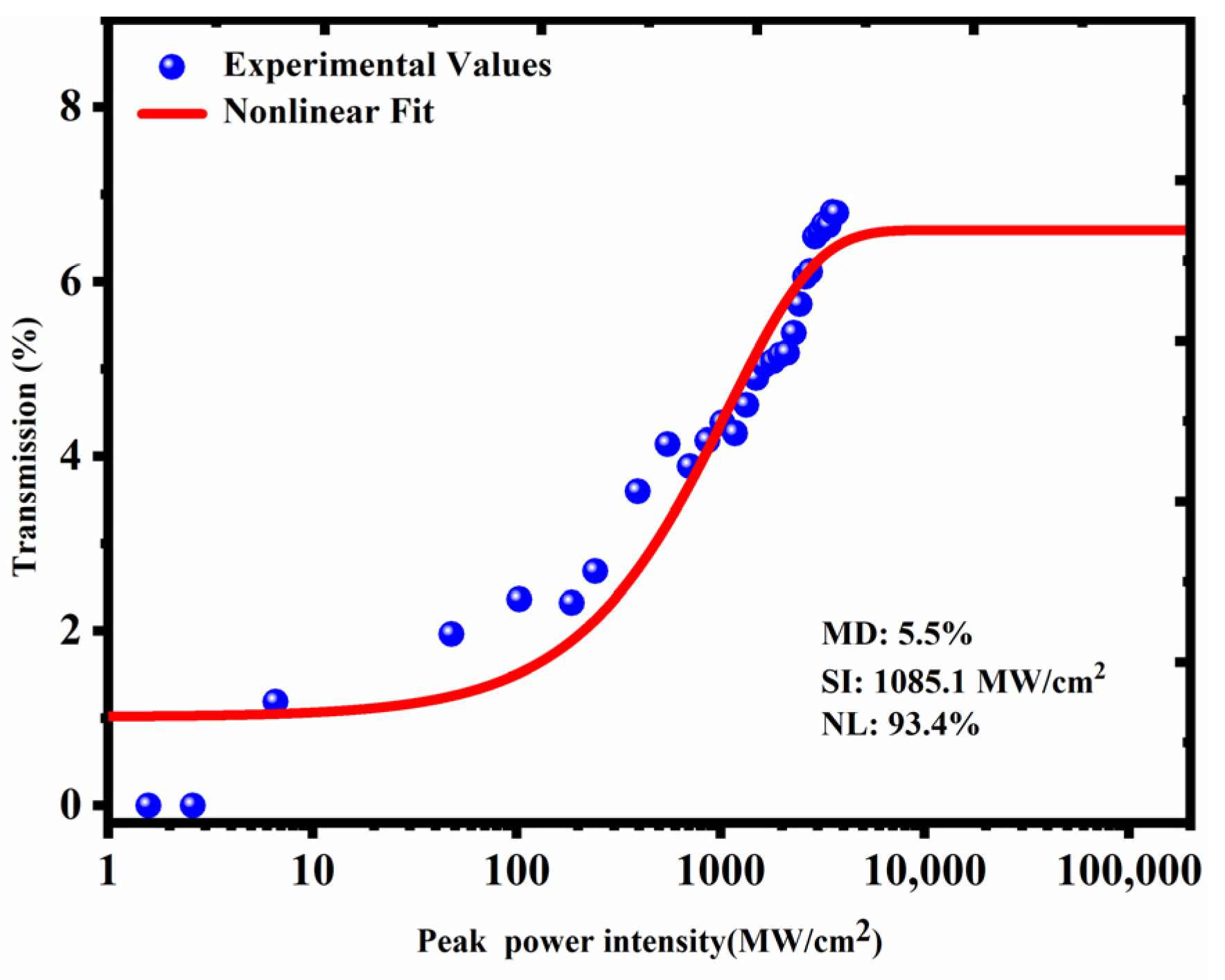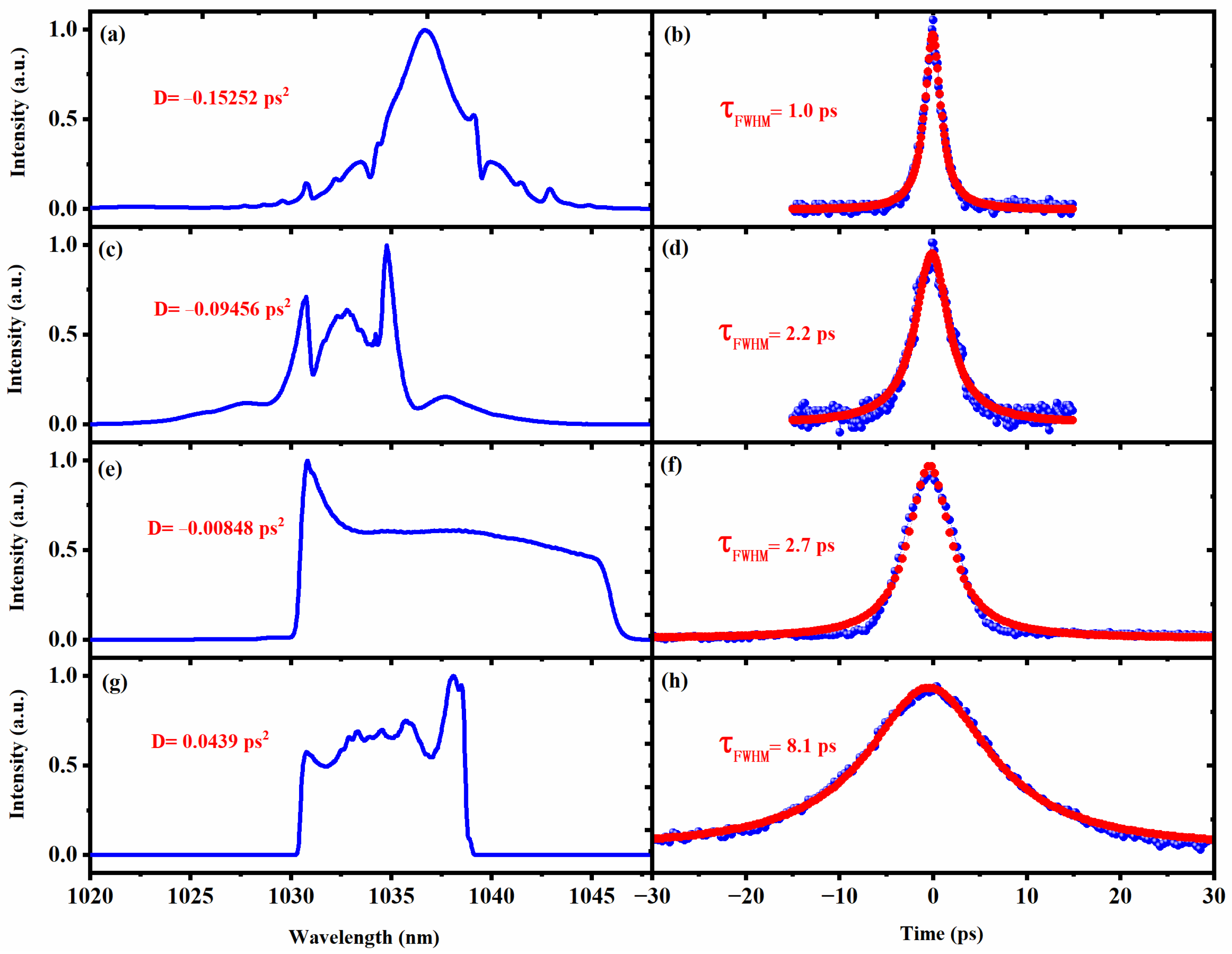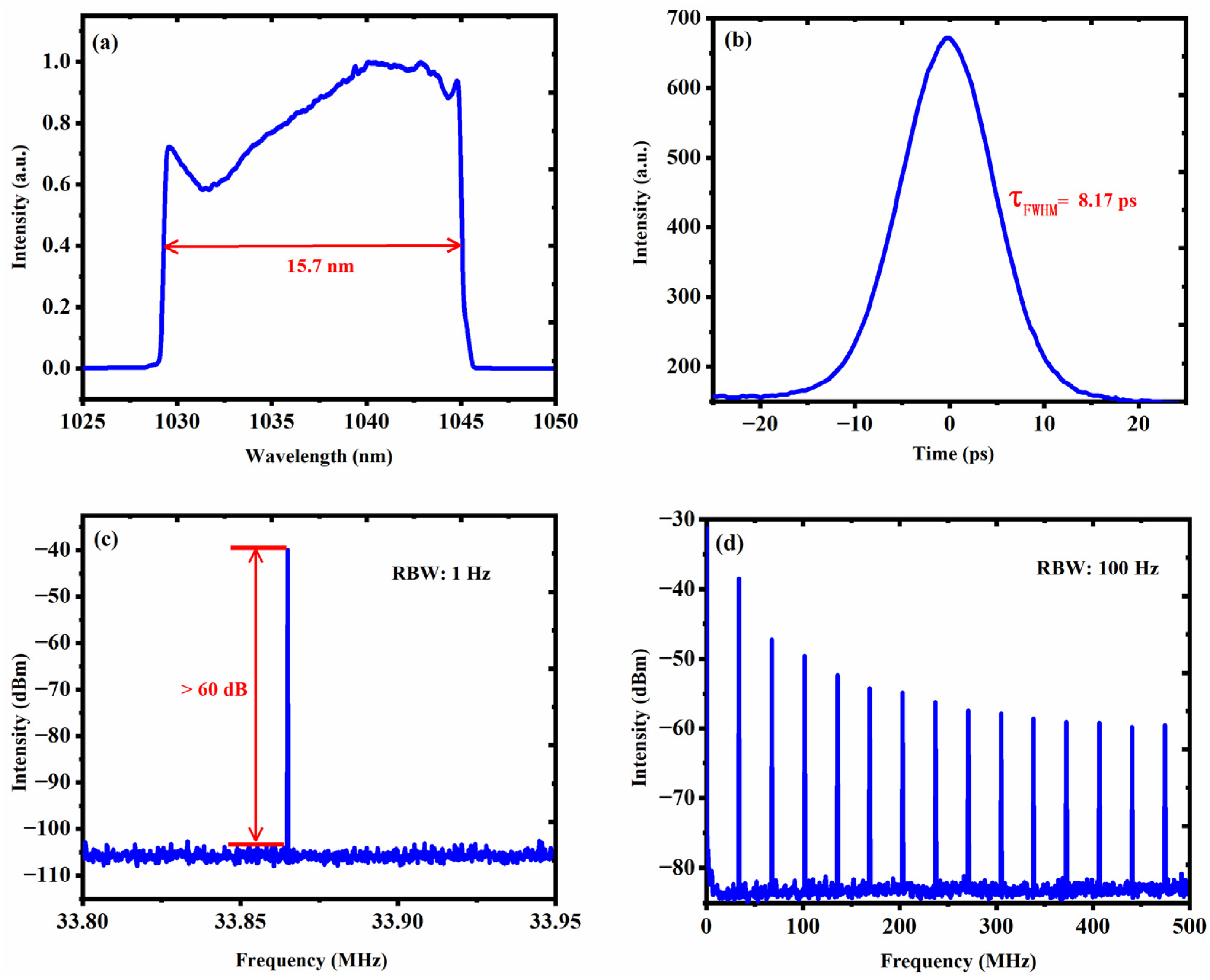Dispersion Management Nonlinear Multimode Interference Mode-Locked Ytterbium Fiber Laser
Abstract
:1. Introduction
2. Experimental Setup
3. Results and Discussion
4. Summary
Author Contributions
Funding
Data Availability Statement
Acknowledgments
Conflicts of Interest
References
- Fermann, M.E.; Hartl, I. Ultrafast fibre lasers. Nat. Photonics 2013, 7, 868–874. [Google Scholar] [CrossRef]
- Yu, X.; Luo, J.; Xiao, X.; Wang, P. Research Progress of High-Power Ultrafast Fiber Lasers. Chin. J. Lasers 2019, 46, 85–96. [Google Scholar]
- Isomaki, A.; Okhotnikov, O.G. Femtosecond soliton mode-locked laser based on ytterbium-doped photonic bandgap fiber. Opt. Express 2006, 14, 9238–9243. [Google Scholar] [CrossRef] [PubMed]
- Saraceno, C.J.; Schriber, C.; Mangold, M.; Hoffmann, M.; Heckl, O.H.; Baer, C.R.E.; Golling, M.; Südmeyer, T.; Keller, U. SESAMs for High-Power Oscillators: Design Guidelines and Damage Thresholds. IEEE J. Sel. Top. Quantum Electron. 2012, 18, 29–41. [Google Scholar] [CrossRef]
- Steinmeyer, G.; Sutter, D.H.; Gallmann, L.; Matuschek, N.; Keller, U. Frontiers in Ultrashort Pulse Generation: Pushing the Limits in Linear and Nonlinear Optics. Science 1999, 286, 1507–1512. [Google Scholar] [CrossRef] [Green Version]
- Zeng, Y.; Fan, W.; Wang, X. The combined effects of intra-cavity spectral filtering on the fiber mode-locked laser. Opt. Commun. 2020, 474, 126152. [Google Scholar] [CrossRef]
- Yan, Z.; Li, X.; Tang, Y.; Shum, P.P.; Yu, X.; Zhang, Y.; Wang, Q.J. Tunable and switchable dual-wavelength Tm-doped mode-locked fiber laser by nonlinear polarization evolution. Opt. Express 2015, 23, 4369–4376. [Google Scholar] [CrossRef] [PubMed] [Green Version]
- Wang, Q.; Chen, T.; Zhang, B.; Heberle, A.P.; Chen, K.P. All-fiber passively mode-locked thulium-doped fiber ring oscillator operated at solitary and noiselike modes. Opt. Lett. 2011, 36, 3750–3752. [Google Scholar] [CrossRef]
- Fermann, M.E.; Stock, M.L.; Andrejco, M.J.; Silberberg, Y. Passive mode locking by using nonlinear polarization evolution in a polarization-maintaining erbium-doped fiber. Opt. Lett. 1993, 18, 894–896. [Google Scholar] [CrossRef]
- Li, J.; Zhang, Z.; Sun, Z.; Luo, H.; Liu, Y.; Yan, Z.; Mou, C.; Zhang, L.; Turitsyn, S. All-fiber passively mode-locked Tm-doped NOLM-based oscillator operating at 2-μm in both soliton and noisy-pulse regimes. Opt. Express 2014, 22, 7875–7882. [Google Scholar] [CrossRef]
- Jin, X.; Wang, X.; Wang, X.; Zhou, P. Tunable multiwavelength mode-locked Tm/Ho-doped fiber laser based on a nonlinear amplified loop mirror. Appl. Opt. 2015, 54, 8260–8264. [Google Scholar] [CrossRef] [PubMed]
- Aguergaray, C.; Broderick, N.G.R.; Erkintalo, M.; Chen, J.S.Y.; Kruglov, V. Mode-locked femtosecond all-normal all-PM Yb-doped fiber laser using a nonlinear amplifying loop mirror. Opt. Express 2012, 20, 10545–10551. [Google Scholar] [CrossRef] [PubMed]
- EDing, E.; Lefrancois, S.; Kutz, J.N.; Wise, F.W. Scaling Fiber Lasers to Large Mode Area: An Investigation of Passive Mode-Locking Using a Multi-Mode Fiber. IEEE J. Quantum Electron. 2011, 47, 597–606. [Google Scholar]
- Nazemosadat, E.; Mafi, A. Nonlinear multimodal interference and saturable absorption using a short graded-index multimode optical fiber. J. Opt. Soc. Am. B 2013, 30, 1357–1367. [Google Scholar] [CrossRef] [Green Version]
- Nazemosadat, E.; Mafi, A. Nonlinear switching in multicore versus multimode waveguide junctions for mode-locked laser applications. Opt. Express 2013, 21, 30739–30745. [Google Scholar] [CrossRef] [PubMed]
- Renninger, W.H.; Wise, F.W. Optical solitons in graded-index multimode fibres. Nat. Commun. 2013, 4, 1719. [Google Scholar] [CrossRef] [Green Version]
- Wright, L.; Christodoulides, D.; Wise, F. Controllable spatiotemporal nonlinear effects in multimode fibers. Nat. Photonics 2015, 9, 306–310. [Google Scholar] [CrossRef]
- Li, H.; Wang, Z.; Li, C.; Zhang, J.; Xu, S. Mode-locked Tm fiber laser using SMF-SIMF-GIMF-SMF fiber structure as a saturable absorber. Opt. Express 2017, 25, 26546–26553. [Google Scholar] [CrossRef]
- Teğin, U.; Ortaç, B. All-fiber all-normal-dispersion femtosecond laser with a nonlinear multimodal interference-based saturable absorber. Opt. Lett. 2018, 43, 1611–1614. [Google Scholar] [CrossRef] [Green Version]
- Dong, Z.; Li, S.; Chen, R.; Li, H.; Gu, C.; Yao, P.; Xu, L. Mode-locked ytterbium-doped fiber laser based on offset-spliced graded index multimode fibers. Opt. Laser Technol. 2019, 119, 105576. [Google Scholar] [CrossRef]
- Thulasi, S.; Sivabalan, S. Hybrid structure based on no-core and graded-index multimode fibers as saturable absorber for a self-starting mode-locked Yb-doped fiber laser. Appl. Opt. 2020, 59, 7357–7363. [Google Scholar] [CrossRef] [PubMed]
- Dong, Z.; Lin, J.; Li, H.; Li, S.; Tao, R.; Gu, C.; Yao, P.; Xu, L. Generation of mode-locked square-shaped and chair-like pulse based on reverse saturable absorption effect of nonlinear multimode interference. Opt. Express 2019, 27, 27610–27617. [Google Scholar] [CrossRef] [PubMed]
- Lv, Z.; Yang, Z.; Song, D.; Li, F.; Yang, X.; Yang, Y.; Wang, Y.; Li, Q.; Zhao, W. Nonlinear multimodal interference for ytterbium-doped all-fiber mode-locking noise-like pulse generation. Appl. Phys. Express 2019, 12, 022004. [Google Scholar] [CrossRef]
- Gupta, P.K.; Singh, C.P.; Mukhopadhyay, P.K.; Bindra, K.S. All-normal dispersion ytterbium-doped fiber laser mode locked by nonlinear multimode interference. Appl. Opt. 2021, 60, 3888–3894. [Google Scholar] [CrossRef]
- Zhang, B.; Ma, S.; Lu, S.; He, Q.; Guo, J.; Jiao, Z.; Wang, B. All-fiber mode-locked ytterbium-doped fiber laser with a saturable absorber based on the nonlinear Kerr beam cleanup effect. Opt. Lett. 2020, 45, 6050–6053. [Google Scholar] [CrossRef]
- Chang, S.; Wang, Z.; Wang, D.; Zhu, T.; Hua, K.; Gao, F. Tunable and dual-wavelength mode-locked Yb-doped fiber laser based on graded-index multimode fiber device. Opt. Laser Technol. 2021, 140, 107081. [Google Scholar] [CrossRef]
- Cheng, P.; Han, M.; Li, Q.; Shu, X. Generation of different mode-locked states in a Yb-doped fiber laser based on nonlinear multimode interference. Opt. Express 2022, 30, 35911–35922. [Google Scholar] [CrossRef]
- Qi, Y.; Zhang, Y.; Yang, S.; Bai, Z.; Ding, J.; Wang, Y.; Lu, Z. Controllable multiple-pulse dynamic patterns in the mode-locking ultrafast laser with a GIMF-YDF-based saturable absorber. Opt. Laser Technol. 2022, 153, 108274. [Google Scholar] [CrossRef]
- Wang, Z.; Wang, D.; Yang, F.; Li, L.; Zhao, C.; Xu, B.; Jin, S.; Cao, S.; Fang, Z. Er-Doped Mode-Locked Fiber Laser With a Hybrid Structure of a Step-Index–Graded-Index Multimode Fiber as the Saturable Absorber. J. Light. Technol. 2017, 35, 5280–5285. [Google Scholar] [CrossRef]
- Jiang, H.; Li, H.; Hu, F.; Ren, X.; Li, C.; Xu, S. Mode-Locked Tm Fiber Laser With a Tapered GIMF SA Based on Nonlinear Multimode Interference Effect. IEEE Photon-Technol. Lett. 2020, 32, 503–506. [Google Scholar] [CrossRef]
- Xin, Y.; Shen, H.; Zhang, S.; Li, X.; Liu, J.; Yan, D. Tunable Multi-Wavelength Bright-Dark and Dark-Bright Pulse Pairs Fiber Lasers. IEEE Photon-J. 2020, 12, 7103209. [Google Scholar] [CrossRef]
- Chen, J.; Wang, D.N.; Wang, Z. Wavelength-Switchable Multiple Type Bound Solitons in a Passively Mode-Locked Er-Doped Fiber Laser. IEEE Photon-Technol. Lett. 2020, 32, 1447–1450. [Google Scholar] [CrossRef]
- Wu, C.; Yao, Y.; Wu, Q.; Yang, Y.; Wu, Z.; Yang, Y.; Tian, J.; Xu, K. Different types of noise-like pulse in a nonlinear multimodal interference based mode-locked fiber laser. Opt. Laser Technol. 2022, 147, 107681. [Google Scholar] [CrossRef]
- Ren, X.; Li, H.; Zhang, Z.; Zhang, J.; Xu, S. Generation of bound solitons in a mode-locked Tm-doped fiber laser based on a graded-index multimode fiber saturable absorber. Opt. Laser Technol. 2022, 149, 107865. [Google Scholar] [CrossRef]





| Method | Central Wavelength/nm | 3 dB Bandwidth/nm | Modulation Depth/% | Pulse Width/ps | Repetition Rate/MHz | Output Power/mW | Ref. |
|---|---|---|---|---|---|---|---|
| SIMF-GIMF | 1030 | 7.3 | 85 | 5 | 44.25 | 5.8 | [19] |
| GIMF1-GIMF2 | 1040 | 12.3 | 15.28 | 11 | 27.32 | 3.11 | [20] |
| NCF-GIMF | 1034.2 | 4 | 24.7 | 2.4 | 21.35 | 2.7 | [21] |
| GIMF1-GIMF2 | 1063.42 | 0.62 | 10 | 350 | 1.83 | - | [22] |
| SIMF-GIMF | 1029 | 7.5 | - | 23.9 | 40 | 37 | [23] |
| SIMF | 1045 | 0.6 | - | 180 | 9 | 1.41 | [24] |
| GIMF | 1043 | 9.2 | 50.5 | 26.38 | 27.57 | 7.02 | [25] |
| GIMF | 1032.3, 1054.1 | 5, 4 | - | - | 18.22, 18.23 | - | [26] |
| GIMF | 1032 | 5 | 8.8 | 10.67 | 16.67 | - | [27] |
| GIMF-YDF | 1064.14 | 0.04 | 12 | 105 | 11 | - | [28] |
| SIMF-GIMF | 1028 | 2.18 | 5.5 | 1.152 | 33.58 | 22 | This work |
Disclaimer/Publisher’s Note: The statements, opinions and data contained in all publications are solely those of the individual author(s) and contributor(s) and not of MDPI and/or the editor(s). MDPI and/or the editor(s) disclaim responsibility for any injury to people or property resulting from any ideas, methods, instructions or products referred to in the content. |
© 2023 by the authors. Licensee MDPI, Basel, Switzerland. This article is an open access article distributed under the terms and conditions of the Creative Commons Attribution (CC BY) license (https://creativecommons.org/licenses/by/4.0/).
Share and Cite
Wang, S.; Lv, Z.; Qiu, J. Dispersion Management Nonlinear Multimode Interference Mode-Locked Ytterbium Fiber Laser. Nanomaterials 2023, 13, 535. https://doi.org/10.3390/nano13030535
Wang S, Lv Z, Qiu J. Dispersion Management Nonlinear Multimode Interference Mode-Locked Ytterbium Fiber Laser. Nanomaterials. 2023; 13(3):535. https://doi.org/10.3390/nano13030535
Chicago/Turabian StyleWang, Shan, Zhiguo Lv, and Jintao Qiu. 2023. "Dispersion Management Nonlinear Multimode Interference Mode-Locked Ytterbium Fiber Laser" Nanomaterials 13, no. 3: 535. https://doi.org/10.3390/nano13030535




